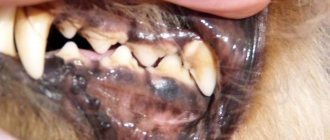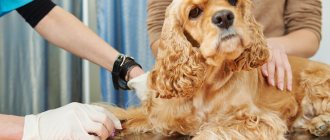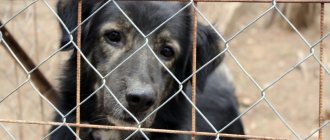On our website you can find a lot of advertisements for Dobermann puppies for sale. These can be private individuals who distribute offspring from their pets, as well as fairly well-known nurseries that can offer dogs from well-known manufacturers if they have all the relevant documentation. If you need to buy a Doberman puppy, read this article carefully. In it we will indicate the main points that you need to pay attention to when choosing a dog of this breed, which will be subject to certain requirements in the future. So, how to choose the right Doberman puppy?
Interesting facts about the character of Dobermans
Representatives of this breed seem formidable and dangerous in appearance, but this is not so.
Behind the frightening appearance lies a kind, obedient pet. Interesting facts about the character of Dobermans:
- Dogs are not used to solving problems by biting and attacking, so you should not expect aggression from your pets.
- Dog breeders and dog handlers note its positive qualities. These include helpfulness, obedience, intellectual abilities and the desire to make concessions. This makes it possible to teach your pet any command or duty.
- Developed protective and security instincts. An owner with a strong character is able to direct these actions in the right direction.
- Sensitivity. Dobermans sense and adopt minor changes in the owner’s mood. This means that pets will always be loyal to humans.
- The desire for an active life. The breed is distinguished by its love of movement and games, so regular walks in the fresh air are required.
Purebred Dobermans in most cases have friendly and submissive parents. For breeding, only the best individuals in appearance, character, and behavior are taken. The goal is to obtain generations of animals only with the correct breed qualities.
Remember! Aggressive Dobermans appear, but only in situations where they were bred to develop fighting qualities. The goal is first places in fights. Vicious dogs also appear during accidental mating.
Puppies
Knowledge of breed development norms will allow you to detect violations in time and take appropriate measures.
Below are the average height and weight standards for a Doberman puppy by month:
Age (months) Height boy/girl (cm) Weight boy/girl (cm)
| 1 | 27/22 | 3,8/3,5 |
| 2 | 40/33 | 8,7/7,8 |
| 3 | 49/43 | 14/12,3 |
| 4 | 56/50 | 18,5/16,5 |
| 5 | 60/55 | 22,6/22,2 |
| 6 | 64/58 | 26/23 |
| 7 | 66/60 | 27,9/24,6 |
| 8 | 68/62 | 29,6/25,5 |
| 9 | 69/63 | 31,1/26,7 |
| 10 | 70/64 | 33/27,5 |
| 11 | 71/65 | 34/28 |
| 12 | 72/65 | 35/29 |
Dobermans' attitude towards children
The slightly intimidating appearance of Dobermans hides an affectionate and loving character underneath. The peculiarity of the breed is sociality; communication with the owners is important for these dogs. Thanks to their intellectual abilities and strong-willed character, Dobermans become full-fledged members of the family.
Dobermans' attitude towards children:
- goodwill - the pet will happily accept the appearance of a new family member, will love the child as much as the owner;
- tenderness - Dobermans quickly become attached to children, constantly play active games with them without causing harm;
- understanding - dogs feel the insecurity and weakness of children, so they try to protect them from the dangers of the outside world;
- patience – pets can endure being rolled on their back, grabbed by the ears and tail, and hugged by children for a long time.
Important! It should be remembered that Dobermans have a limit to their patience. Severe pain will force dogs to growl or snap, so it is worth explaining to children that they should not grab or pull their pet for a long time.
Love and a friendly attitude allow you to leave your pets alone with the child. The pet will not harm a family member. However, the dog may perceive loud conversations, crying and sudden movements when playing with adults or other people's children as a threat to the owner's child. In this case, the pet will begin to show aggression, barking and growling as a sign of protection. Therefore, it is not recommended to leave Dobermans with strangers.
For a child, a Doberman is a good companion, but only if the pet is raised correctly. If you do not train, the dog will behave unpredictably.
First vaccinations
Usually, a puppy's first vaccinations are given at the age of 13-14 weeks . Since it is during this period that the dog’s immune system is formed.
The puppy immediately receives a complex of vaccines against parvovirus enteritis, plague, adenoviral hepatitis, and leptospirosis.
After 21-28 vaccinations are repeated . Then the same procedure is carried out when the dog is one year old.
Doberman behavior when a child appears in the house
The breed's sensitivity is an important character trait. Dogs adopt the owner’s mood and emotions towards other people, new family members. Therefore, these dogs generally have a positive reaction to the birth of a child.
The Doberman's behavior when a child appears in the house is alertness and curiosity. First of all, an acquaintance is required. To do this, it is recommended to carefully and calmly introduce the baby to the dog.
The main thing is to tell the pet that he has a friend who needs to be protected and loved. The first thing a Doberman will do is sniff the child. If the stage is successful, then there will be no problems in the future, since the breed is understanding and smart.
ZKS - protective guard service
For a Doberman, training in basic commands and OKD is quite enough. After such training, the owner will receive a disciplined, loyal dog.
However, many people prefer to send the dog for additional training, because the Doberman is a breed bred as a bodyguard.
The problem for dog lovers is that they get a pet simply because they like the appearance, completely ignoring the original purpose of the breed.
In order for the dog to feel comfortable and be “in business”, he must be given the opportunity to do what is genetically inherent in him. In the case of the Doberman, this is the owner's protection. Therefore, ZKS is a good solution.
The dog is allowed to participate in the course if it passes the stress test.
Training includes:
- impact protection;
- pursuit of the enemy;
- recognition of dangerous objects;
- aggression control.
Important! The ZKS is intended to protect the owner, and not to attack a person.
Differences in the attitude of females and males towards children
The attitude towards the younger family member largely depends on the gender of the pet, since males and females differ somewhat in behavior or temperament. The difference in the attitude of females and males towards children:
- Males are distinguished by their desire for freedom. The pet plays with the child and protects him from danger, but often behaves passively. The dog usually lies for a long time, not paying attention to the pestering from the baby.
- Bitches often exhibit maternal instincts. The female accepts each child. The dog will not leave the baby alone and will always come to the rescue. Maternal instinct sometimes takes over, and the dog begins to think that there are puppies in front of her. It is recommended to stop this moment immediately, otherwise the bitch will treat all people approaching the child with aggression.
Each dog is individual. The behavior of bitches and dogs often differs from normal manifestations. So, dogs can be more caring, affectionate and attentive than females.
Features of care
Combing
The Doberman's muscular body is covered with straight, short hair. It does not require special care.
If your dog gets very dirty during a walk, you can wipe it off with a damp towel. They can also remove fur during shedding.
But a furminator .
You need to bathe your dog 2 times a year. The claws on the paws are periodically trimmed.
The Doberman Pinscher loves long walks. He happily accompanies his owners while jogging and cycling. You can walk your dog with minimal effort by throwing him a tennis ball or a stick.
The Doberman's body is practically devoid of fat and undercoat. It looks impressive: the dog is flexing its muscles.
But this feature has made Dobermans susceptible to cold: owners need to take care of a blanket for cold weather.
For the same reason, a dog cannot be a watchman in the yard in winter.
Ear cropping
If breeders do tail docking immediately after the dog is born, then all the problems associated with ear surgery fall on the shoulders of the new owners.
It is best to crop ears between 7 and 13 weeks of age. This procedure is not necessary: cropped ears are a purely decorative element.
In some countries, artificial reshaping of the ears is prohibited. A long-tailed Doberman with floppy ears is no longer a rarity, but rather the rule.
Clubs from 34 countries that are members of the FCI do not allow docked animals to participate in exhibitions.
The Doberman's body is practically devoid of fat and undercoat. It looks impressive: the dog is flexing its muscles. But this feature has made Dobermans susceptible to cold: owners need to take care of a blanket for cold weather. For the same reason, a dog cannot be a watchman in the yard in winter.
Walk
Temperamental Dobermans need long walks. They do not do well in a cramped apartment. They cannot be kept in closed enclosures either.
The ideal option is a large courtyard of a country house.
Puppies need to be taught to go for walks from an early age. Contacts with people will make the puppy fearless and self-confident, and teach him to behave prudently.
Adult dogs love long walks. They are happy to accompany their owners while jogging and cycling.
With minimal effort, you can walk your dog by throwing him a tennis ball.
In crowded places, you should fasten your pet with a harness .
Temperamental Dobermans need long walks. They do not do well in a cramped apartment. They cannot be kept in closed enclosures either. The ideal option is a large courtyard of a country house
Nutrition
This aristocrat is quite unpretentious in food. Ready-made dry food and natural nutrition are suitable for him
The dog loves meat very much, but it should not be more than 40% of the total diet. It is combined with:
- porridge;
- cottage cheese and fermented milk products;
- boiled sea fish without bones;
- bran and vegetables.
This article will tell you more about what cereals you can feed dogs.
For adult dogs, one meal per day is enough. But usually they are fed twice: in the morning and at lunch.
Doberman Pinschers are real superheroes, ready to help at any time.
Is it worth getting a Doberman for a child in an apartment?
To answer, you will need to compare the pros and cons. Advantages:
- love for children - properly raised Dobermans will never offend or cause harm;
- patience with long games, tugging of the tail, ears;
- protection, protecting children from dangers - falling, getting on the road.
Disadvantages include the desire for diversity. If Dobermans get bored, they stop paying attention to what is happening, which children do not like. The decision is made by parents after weighing the pros and cons.
Photos of what newborns look like
Newborn Doberman puppies are born completely helpless, blind and deaf . Newborn Dobermans have no teeth and do not know how to regulate body heat.
The first two weeks after birth, the puppy's needs are very limited - food, sleep and warmth. Previously, during this period, puppies' ears and tails were docked, but now they often do not dock them.
Newborn puppies have an elastic, dense body, large paws and heads.
At one month the puppy's weight is already 3.5-4 kg, body length 22-27 cm.
Cases of Doberman attacks on children
Are there any known cases of Dobermans attacking children? Dogs of this breed often show aggression, but only towards strangers. Dobermans are friendly towards family members. If you start raising a pet from a young age, there will be no problems.
The dog needs an owner with a firm hand, who will show who is in charge in the family. If no cases of aggression have been observed in the Doberman, then there is no need to fear for the child.
Dobermans get along well with children. Dogs love active games and entertainment, and are patient with pranks. The main advantage is that pets rarely bite; they usually only show negative emotions by growling. Doberman Pinschers make excellent nannies if trained correctly.
History and origin of the breed
The breed appeared at the end of the 19th century. It got its name in honor of its creator, the German scientist Karl Friedrich Louis Dobermann. It is not known exactly from which breeds Dobermans originated, but their ancestors are called Rottweilers, herding dogs and German pinschers.
Initially, the breed was called the “Thuringian Pinscher”, in honor of the city in which it originated. However, it was later renamed. Currently, the word "pinscher" is also omitted from the name.
Otto Goeller played a major role in the development of Dobermans. He perfected the Dobermann tradition, becoming the “father of the breed” as we know it today.
Options
Let's start describing the breed with its appearance. The height of a male Doberman at the withers is 66-71 cm, that of a female is 61-66 cm. The weight of an adult is 30-40 kg. The head is narrow, elongated, the transition from the forehead to the muzzle is pronounced. The teeth are strong. The eyes are dark. Ears are erect. The neck is long and graceful. The tail is docked and set high. The withers of males usually protrude strongly, defining the direction from the croup to the back.
The body of the Doberman is short, but in females the lumbar region is longer, due to the need to have space for the mammary glands . The belly is noticeably tucked in. The coat is short, hard, lying close to the body. Color: black with brown markings, chocolate, blue; white Dobermans (albino Dobermans) with light fur and eyes are extremely rare.
Pedagogical difficulties
The Doberman is rightfully considered an ideal service dog .
Legends are formed about the diligence, obedience and service zeal of the breed. But to consider the breed easy to train would be a serious mistake. One of the necessary selection parameters for the “gendarme dog” was the ability to make independent decisions and work “alone.” Independence implies the highest intelligence: all Dobermans are amazingly smart. Along with intelligence, the owner receives terrible stubbornness and willfulness. Dobermans perfectly recognize the strongest in the family hierarchy, easily integrate into the system of relationships and obey only the leader. The dog will, of course, protect the owner’s children, but by definition will not obey the child’s commands.
Dobermans get sick from “lying on their sides” on the sofa; boredom and monotony of the situation drives the dogs into the wildest depression. Active and active dogs need constant movement and busyness. Otherwise, Dobermans simply “fly off the rails.”
Finding a use for service talents, giving an opportunity to splash out energy and enthusiasm, creating a feeling of employment, necessity and usefulness is the main task of the Doberman owner.
How to distinguish a boy from a girl?
To determine the gender of a puppy, simply examine it..
In young male dogs, a little below the navel there will be a small protrusion covered with rolls of skin - this is the penis, and in the perineal area you will see thickly growing hair. In the future there will be testicles here.
In girls, you will not find the characteristic protrusion and fur on the tummy. But if you look under the tail, you will see a small seal resembling a loop. This is the genital slit (loop).
How to bathe properly?
Bathing stages:
- Before bathing, you should definitely brush the puppy, and since the Doberman's coat is short and smooth, this will not be difficult. This is rather a stage of moral preparation. When combing, talk to your baby, try to set him up in a positive way.
- Preparing a place for swimming. If your puppy is too young, bathing him in a sink or small tub is fine. For an older puppy, bathe it in a regular bath. Place a rubber mat at the bottom of the bathtub or sink to prevent your baby's paws from moving apart. Now fill the bathtub with water. There should not be a lot of water in the bath; bathing should under no circumstances frighten the baby.
- The optimal water temperature is 38-39 degrees (as for bathing a child).
- Choose a special shampoo designed specifically for dogs for bathing.
- Now put your baby in the bath and start washing, rubbing in the shampoo with a soft sponge or cloth. And remember the first bath is always stressful for the dog, try to be as gentle and patient with the puppy as possible. After you finish washing, rinse your dog thoroughly several times. If there is no foam left in the bath, then rinsing can be completed.
- Drying. After you have bathed your baby, wrap him in soft logs and gently dry him, then dry him with a hairdryer.
NOTE!
If your pet behaves well during bathing, be sure to reward him with a treat.











